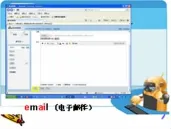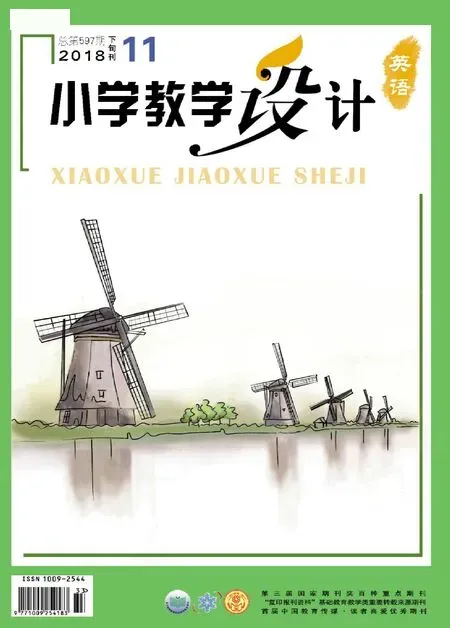修订版PEP 五(上)Unit 4 What can you do?B Read and write
王淑文
教学过程
Step 1.Pre-reading(阅读前——创境激趣,预测设疑)
1.Greeting and free talk
T:Good morning,everyone!I’m Your new friend.My name is Wang Shuwen.You can call me Ms Wang.Nice to meet you.I want some new friends.Do you want to be my friend?What do you want to know about me?
S1/2/3:Talk with Ms Wang.(What’s your favourite food?What’s your favourite drink?What can you do at home?What can you do at school?And so on.)
2.Brain storm
T:(PPT Shows the pictures.逐图出示,并与学生适时交流)I want to know more about you.Look at the pictures. Say a sentence as quickly as you can.I can...I can’t...
S1~Sn:Ican.../Ican’t...(dance,singEnglish songs,do kung fu,play the pipa,draw cartoons, swim, cook, speak English,playping-pong, play basketball.)
3.Guess and say
T:Excellent work! Look!Our friend Robin wants a new friend.He is writing an email to us.(图片情境中理解email并指导发音,见图1)

图1
T:What do you know about Robin?
S1:Robin is clever.
S2:Robin is strong.
S3:He can cook.
T:What else do you want to know?
S1:What can Robin do?What can’t he do?
T:Look at the picture and guess(见图 2).
S1~Sn:Robin can...Robin can’t...
设计意图:在自然的口语交流中拉近师生距离,在Brain storm中复习短语和句子。通过预测激发学生对文本的阅读兴趣。
Step 2.While-reading(阅读中——自主学习,交流解疑)
1.Listen and draw(听力输入,整体感知)

图2
T:Robin wants to make new friends.He is writing an email to us.What can he do?What can’t he do?Let’s listen and draw a happy face or a sad face(见图 3).

图3
Ss:Listen and draw.
T:Check the answer.
设计意图:预测激趣后,以听音方式整体输入文本,感知语篇,初步了解Robin能做和不能做的事情。
2.Read and answer.(快速阅读,回答问题)
T:What’s Robin like?Read the email quickly and find the answer.
Ss:Read and answerthe question(见图 4).

图4
S1:He’s friendly and funny.
设计意图:通过快速阅读回答问题,培养学生略过无关信息,寻找关键信息并准确表达的能力。
3.Read and judge(细节阅读,处理信息,深入理解,组内交流)
T:Look at Robin’s email,read it silently and carefully.Then finish the questions.Where do you find the answer?Please underline the sentences.After that,discuss and show.
Ss:Read and tick or cross.Then discuss in group.One team shows the answer in class(见图 5).

图5
设计意图:自主阅读,学会寻找并处理信息,在合作与交流中纠错。
4.Read,ask and answer(自由读文,质疑与解答)
T:Read thepassageagain,and circle the words you can’t read or understand.Then discuss in your group.
Ss:自主读文,圈出不能准确朗读或者理解的单词、句子,在组内提出并交流解答,说说解决的方法。
预测问题:Want,Tryme!Please send me an emailat robin@urfriend.cn.
联系短文、图片理解文本。
T:Good job.(根据学生学习中出现的困难,结合电子邮件图片,有针对性地指导理解与朗读)
设计意图:在阅读中挑战,在交流中解决问题,深入理解语篇内容。
Step 3.Post-reading(阅读后——读写结合,拓展运用)
1.Listen and repeat
设计意图:听音模仿Robin的声音,激发学生朗读的兴趣,培养良好的语音模仿意识。
2.Read the passage(可选)
T:Show the reading tips.
(1)声音洪亮,按正确的语音、语调和意群朗读。
(2)方式可选:Robin模仿版;2017生活智能语音版。
Ss:Read and act.
设计意图:在朗读中体验语篇学习的乐趣。
3.Retell the email
T:Look at the mind map,and retell the email(见图6).

图6
Ss:Retell the email in pairs,and then show in class.
设计意图:借助板书思维导图复述Robin邮件,进行语言的初步输出。
4.Write
T:Do you want to be Robin’s friend? Introduce yourself and write some sentences about yourself(教师示范,见图7).

图7
Ss:Introduce in pairsand write.
S1:Show the writing.
设计意图:在口头表达的基础上,在邮件情境中根据个人实际写句子,完成电子邮件。
Step4.Homework(分层可选)
1.Listen,repeat or retell the email(听音跟读或复述邮件).
2.Write an email to your friend or Ms Wang(给你的朋友或王老师写一封电子邮件).My email address:hblxwsw@126.com
设计意图:分层可选,学生在实践运用中巩固语言。
·备课资料·
why的基本用法
单词why与字母“y”的发音相同,根据小学英语教学对why一词基本要求,老师们备课时可做如下参考。
一、why用作疑问副词,对原因进行提问。如:
1.—Why are you late today?你今天为什么迟到?
—Because I missed the bus.I’m very sorry.因为我错过了公共汽车。实在对不起。
2.—Why are they all waiting there?他们为什么都在那儿等?
—Because their new teacher will come soon.因为他们的新老师马上会到。
二、why用作语气词,表示惊讶、不耐烦等情绪。如:
1.Why,he can drive a car,too!啊!他也能开车啦!
2.Why,the baby is too noisy today.哎呀!今天宝贝太吵闹了。
3.Why,Linda is ill?什么,琳达生病了?

